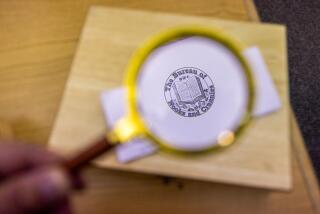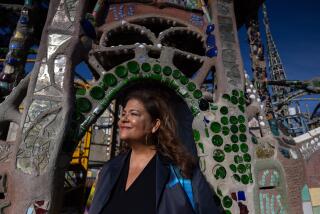Library Saying Thanks for the Memories
To say that the Library of Congress is a stately place is epic understatement. It is the think tank for Congress, the home to the poet laureate, repository for the papers of 23 American presidents and the world’s largest library, period.
Hardly the sort of place one would expect to find 70 years of memorabilia from a beloved song and dance man with a ski-jump nose, not to mention a computerized catalog of 88,000 of his best jokes.
For the record:
12:00 a.m. May 10, 2000 For the Record
Los Angeles Times Wednesday May 10, 2000 Home Edition Part A Part A Page 3 Metro Desk 1 inches; 20 words Type of Material: Correction
Misspelled name-- A column in Tuesday’s editions misspelled the name of the Librarian of Congress. The correct spelling is James H. Billington.
But there it is, opening to the public Wednesday, a Washington-style, hallowed-hall tribute to Bob Hope, one room away from the Calvin Coolidge auditorium and one flight down from the original Guttenberg Bible.
It began three years ago when the library of all libraries requested Hope’s priceless collection of scripts, scrapbooks, notes and jokes, much of it housed in two fire-proof vaults a few hundred feet from his Toluca Lake estate. The UCLA film library made a pitch, as did New York’s Museum of Radio and Television.
But as Hope’s daughter Linda put it: “Ironically, all roads led to the Library of Congress.” It not only had the real estate to display nearly a century of Hope’s work, but proposed a marriage that gave comedy a place in American history and cracked the musty, fusty image of one of Washington’s most wondrous buildings.
A visit to the Bob Hope wing is like finding out that inside those high-button shoes, Whistler’s Mother was wearing red socks. Or that Thomas Jefferson enjoyed a good pie in the face as much as the next forefather.
*
For 18 months, curator Sam Brylawski sorted through the vaults that held memorabilia as old as the scrapbooks Hope’s mother kept. He read letters, reviewed grainy film clips, listened to crackly radio recordings. The result was not only a tribute to Hope, but to vaudeville and the people who spent a century making the country laugh through good times and not.
Hope donated a file of more than 1 million jokes--”of which more than half are good,” chortled his veteran publicist, Ward Grant. They are cataloged by subject in one of the library’s most interactive exhibits.
There are jokes edited in Hope’s own hand, film clips of him dancing with Connie Stevens before a cheering throng of Army troops. There is a letter from a POW shot down over North Vietnam, written three days before his scheduled release, thanking the comedian for his concern: “There have been many a dark and lonesome night when we have felt all but forgotten. . . .”
There is the business card he had printed up at age 20, before he settled on the right first name: “Lester Hope, Will teach you to dance, Buck wing and soft shoe. . . .”
There is his 1924 vaudeville ledger listing on the same bill Jack Benny, Burt Lahr and Burns and Allen; the honorary Oscar he received in 1953; the monologue to his 1970 Academy Awards speech.
Encased in glass is a hand-edited version of “Thanks for the Memories,” the theme song for which he wrote thousands of lyrics to suit the occasion, including a new set weekly for the radio show that ran from 1938 to 1956.
Thanks for the memories
Of agent’s 10 percent,
Those shylocks you all know
My agent saw me buy a suit
Said “Look he wastes my dough. . . . “
And jokes for every imaginable topic.
Example: Too Many Talk Shows:
There are so many talk shows they’re running out of applause makers. I may have to lend them the one I have over my bed.
*
Nearly 97, Hope does not grant interviews anymore. Although he uses a wheelchair occasionally, he still plays a couple of holes of golf a week, eats In-N-Out Burgers and walks for ice cream. He came to Washington on Saturday with his wife, Dolores, to help inaugurate the exhibit, but he let his family do the talking.
“It’s thrilling to be in such hallowed halls,” Linda Hope said. “It gives a kind of legitimacy to show business which has been such a part of American life.”
This hands-on exhibit in a mostly hands-off library marks a new era in the institution’s long history. First commissioned by Congress in 1800, it was located in the Capitol until it burned during the War of 1812. In 1815, the library was restarted with a collection of 6,400 books sold by Jefferson to Congress for $22,000.
After a renovation three years ago, Librarian of Congress James H. Billinton began a program to make the rare collections more accessible to the public and broaden the image beyond that of a deep research institution where scholars can find almost anything.
The Hope exhibit is intended to reach out to the masses, to teach them something about vaudeville and look behind the curtain at a man who rose from poor immigrant to superstar, without forgetting to give something back.
“I hope people will come away with an appreciation for this man’s talents. I hope they come away with an appreciation of American vaudeville,” said curator Brylawski.
“And I hope they come away laughing.”
More to Read
Sign up for Essential California
The most important California stories and recommendations in your inbox every morning.
You may occasionally receive promotional content from the Los Angeles Times.










